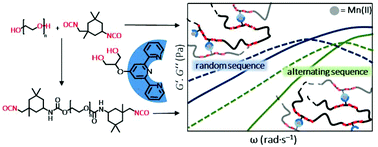Amphiphilic poly(ether urethanes) carrying associative terpyridine side groups with controlled spacing†
Abstract
The rational design of transiently crosslinked polymer gels requires a profound understanding of how molecular and topological factors determine the mechanical and dynamic material properties. To refine so-far established structure–property relations, complementary and versatile model sytems are still a crucial prerequisiste. In this study, the synthesis of a metallo-supramolecular associating terpyridine-diol (referred to as sticker) and its incorporation into poly(ethylene glycol) (pEG) based polyurethanes (PU) with strictly alternating vs. random sequences and variable sticker spacings is described. Synergetic effects resulting from the proximity of multiple neighboring urethane and sticker units in the random PUs are reflected in the hydrogen-bonding characteristics in the melt state as well as in their solution behavior. While the alternating PUs form micellar aggregates in water, whose size strongly depends on concentration and temperature leading to a pEG-length-dependent thermo-responsiveness, the random PUs are water insoluble. Finally, shear rheological measurements performed on manganese(II)-crosslinked PU gels demonstrate severely prolonged network relaxation times and an exacerbated shallowing of the power-lawscaling in the terminal flow regime in case of the random PUs.



 Please wait while we load your content...
Please wait while we load your content...